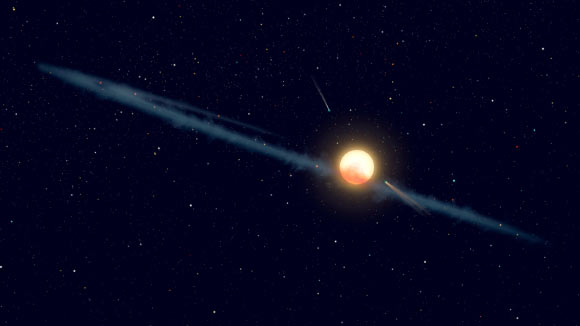Astronomers are one step closer to solving the mystery behind KIC 8462852, a main-sequence F-type star located in the constellation Cygnus, about 1,480 light-years from Earth.

This illustration depicts a hypothetical uneven ring of dust orbiting KIC 8462852. Image credit: NASA / JPL-Caltech.
KIC 8462852, also known as Boyajian’s star, Tabby’s star, TYC 3162-665-1 or 2MASS J20061546+4427248, is about 50% bigger and 1,000 degrees hotter than the Sun.
This star captured astronomers’ imagination in September 2015 with its strangely fluctuating brightness.
Ever since then, the scientific community has been observing this enigmatic character and sifting methodically through the data in search of an answer.
Speculation to account for KIC 8462852’s dips in brightness has ranged from it having swallowed a nearby exoplanet to a swarm of exocomets orbiting the star to a so-called Dyson sphere, a hypothetical energy-gathering structure built by an advanced civilization.
The mystery of KIC 8462852 is so compelling that more than 1,700 people donated over $100,000 through a Kickstarter campaign in support of ground-based telescope time to observe and gather more data on the star.
As a result, a body of data collected by Louisiana State University astronomer Tabetha Boyajian, Penn State’s Jason Wright and their colleagues in partnership with the Las Cumbres Observatory is now available in a paper in the Astrophysical Journal Letters (arXiv.org preprint).
“We were hoping that once we finally caught a dip happening in real time we could see if the dips were the same depth at all wavelengths,” Dr. Wright said.
“If they were nearly the same, this would suggest that the cause was something opaque, like an orbiting disk, planet, or star, or even large structures in space.”
Instead, the team found that KIC 8462852 got much dimmer at some wavelengths than at others.
“Dust is most likely the reason why the star’s light appears to dim and brighten,” Dr. Boyajian said.
“The new data shows that different colors of light are being blocked at different intensities. Therefore, whatever is passing between us and the star is not opaque, as would be expected from a planet or alien megastructure.”
Now there are more answers to be found.
“This latest research rules out alien megastructures, but it raises the plausibility of other phenomena being behind the dimming,” Dr. Wright said.
“There are models involving circumstellar material — like exocomets — which seem to be consistent with the data we have.”
“Some astronomers favor the idea that nothing is blocking the star — that it just gets dimmer on its own — and this also is consistent with this summer’s data.”
“It’s exciting. I am so appreciative of all of the people who have contributed to this in the past year — the citizen scientists and professional astronomers,” Dr. Boyajian said.
“It’s quite humbling to have all of these people contributing in various ways to help figure it out.”
_____
Tabetha S. Boyajian et al. 2018. The First Post-Kepler Brightness Dips of KIC 8462852. ApJL, in press; arXiv: 1801.00732







